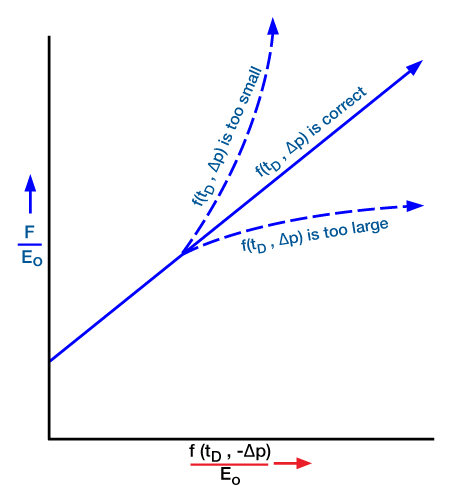Water Drive and the Material Balance Equation
We refer to Havlena and Odeh (1963). The entire MBE equation is
![Rendered by QuickLaTeX.com N_{p}\left [ B_{t}+\left (R_{p}-R_{si} \right )B_{g} \right ]+B_{w}W_{p}=N\, \left [ \left ( B_{t}-B_{ti} \right )+\dfrac{B_ti}{1-S_{wi}}\left ( S_{w}c_{w}+C_{r} \right )\Delta p+m\dfrac{B_{ti}}{B_{gt}}\left ( B_{g}-B_{gi} \right ) \right ]+W_{e}](https://petroshine.com/wp-content/ql-cache/quicklatex.com-e249843c34044137ddcc0c1e97f23d72_l3.png)
For saturated reservoirs, or when We is appreciable, or both, we can ignore compressibility of the rock and its associated water. The MBE becomes
![]() …………(49)
…………(49)
where:
F= total fluid withdrawals in reservoir volumes
Eo= total fluid withdrawals in reservoir volumes =Bt−Bti, and
Eg= gas cap gas expansion =Bg−Bgi
Equation 49 has three possible unknowns: N, m, and We.
When the pressure is above the bubble-point, m = 0, and Equation 49 becomes
![]()
![]() …………(50)
…………(50)
Water influx is a function of time, pressure drop, and the physical properties of the aquifer, such as permeability, size, compressibility, porosity, and viscosity. We write
![]() …………(51)
…………(51)
where:
C= constant
tD= dimensionless time that includes actual time and the physical properties of the aquifer
![]() where, ϕ, μ, ce and Ao are aquifer properties)
where, ϕ, μ, ce and Ao are aquifer properties)
Δp= pressure drop at the oil water interface.
Equation 50 indicates that if We (which is the parameter with the greatest uncertainty) is calculated correctly as a function of time, and a plot of ![]() versus
versus ![]() is made on rectangular coordinate paper, a straight line should occur. The value of
is made on rectangular coordinate paper, a straight line should occur. The value of ![]() when
when ![]() =0 gives N, the initial oil in place. The calculations (Havlena and Odeh 1963, 1964) proceed as follows:
=0 gives N, the initial oil in place. The calculations (Havlena and Odeh 1963, 1964) proceed as follows:
- From the available data estimate the properties of the aquifer and calculate tD as a function of a time interval, for example, at three, six, or nine months.
- From production data calculate
 , and Δp at the selected time intervals.
, and Δp at the selected time intervals. - Calculate f(tD, Δp) of Equation 51 for the selected time intervals.
- Plot
 versus
versus ![Rendered by QuickLaTeX.com \left [\tfrac{ f\left (t_{D},\ \Delta p \right ) }{E_{o} }\right ]](data:image/svg+xml;base64,PHN2ZyB4bWxucz0iaHR0cDovL3d3dy53My5vcmcvMjAwMC9zdmciIHdpZHRoPSI3NyIgaGVpZ2h0PSIzMiIgdmlld0JveD0iMCAwIDc3IDMyIj48cmVjdCB3aWR0aD0iMTAwJSIgaGVpZ2h0PSIxMDAlIiBzdHlsZT0iZmlsbDojY2ZkNGRiO2ZpbGwtb3BhY2l0eTogMC4xOyIvPjwvc3ZnPg==) on rectangular coordinate paper.
on rectangular coordinate paper.
If the selected properties of the aquifer are correct (i.e., if Equation 51 is accurate) the plot will be a straight line (Figure 1).

The slope of the straight line is C, the water influx constant in Equation 51. The extrapolation of the straight line to
![]()
gives the value of N. If the plotted points curve upward, the assumed water influx is too low; on the other hand, if they curve downward, the assumed water influx is too high. New values for the aquifer parameters must be assumed, and the calculations repeated until a straight line occurs. An example of this procedure is beyond the scope of this introductory module, but may be found in Havlena and Odeh (1963, 1964).
 Petro Shine The Place for Oil and Gas Professionals.
Petro Shine The Place for Oil and Gas Professionals.



